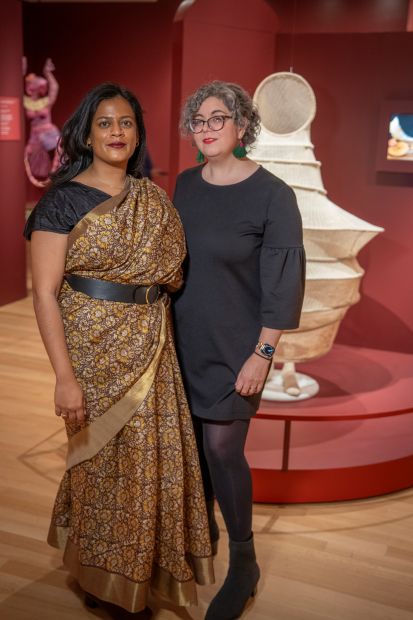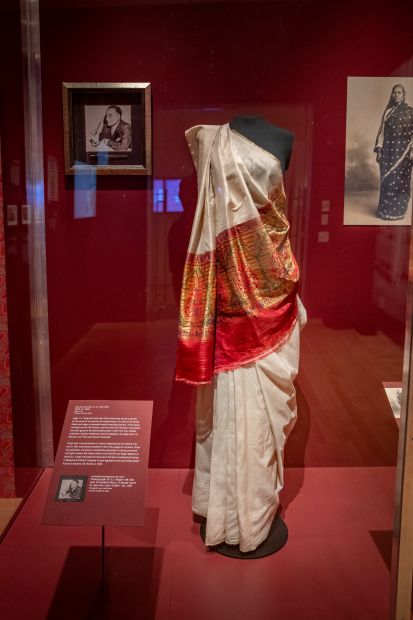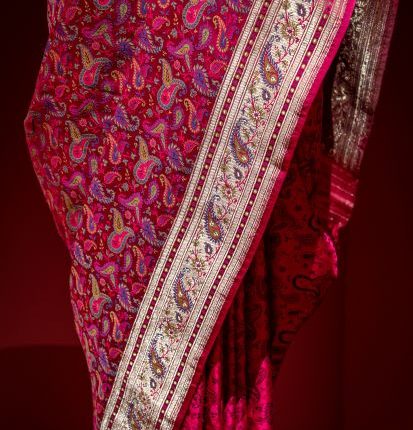The sari as art, and political statement
By Alisha Haridasani Gupta
In the summer of 1929, one of India’s foremost female freedom fighters, Kamaladevi Chattopadhyay, travelled to Berlin with several other delegates to attend a conference of the International Alliance of Women for Suffrage and Equal Citizenship. India was still under British rule, and, as a result, the Indian representatives at the gathering didn’t have a flag.
Kamaladevi, who today is better known by her mononym, saw this as deeply unjust. So she and her delegates cut up their saris to create their own flag to fly at the conference’s opening gala.
“No one grudged tearing up their fineries,” she said, according to a biography, ‘The Art of Freedom: Kamaladevi Chattopadhyay and the Making of Modern India’, by Nico Slate, a professor of history at Carnegie Mellon University. “In fact, we felt free and liberated.”
In an instant, those women turned the sari into a political statement.
Among the oldest-known garments, but one that remains fashionable enough to be spotted on red carpets and runways, the 6- to 9-yard draped fabric that constitutes a sari has long been more than just clothing: It has been a symbol of empowerment, of global trade, of diplomatic soft power and of resistance.

for Women’s History and Anna Danziger Halperin, the director
of the centre at the ‘New York Sari’ exhibition
-Tony Cenicola/The New York Times
That is the idea at the centre of an exhibition at the New York Historical Society, called ‘New York Sari’, which runs through April. The exhibition aims to shine a light on how the garment is woven into the complex histories of the Indian subcontinent and, in unexpected ways, New York City and the United States, and how it “might tell stories about migration and diaspora and struggle,” Salonee Bhaman, a historian and a curator of the exhibition, said while walking a gaggle of visitors through the show last week.
“It’s like a flag that people have used to fashion stories about themselves,” added Bhaman, who was dressed in her own floral, bronze-coloured silk sari (sometimes spelled saree) that, bucking the traditional method of wrapping it around the waist over a petticoat skirt, she had worn over a pair of leggings and clasped it in place with a gold-buckled belt.
Though the teams at the New York Historical and the Centre for Women’s History began conceptualizing the exhibition about 20 months ago, it arrives at a time of frequent anti-immigration rhetoric and crackdowns on immigrants in some American cities. To put up an exhibition that explores how the South Asian immigrant community shaped New York’s history is subversive, Shradha Kochhar, one of the artists featured in the show, said in an interview.
In early September, Kochhar, 29, was in the middle of her own immigration struggle, trying to renew her visa, when she went into the Historical to install her sculpture. That day, her friends texted her to warn her that immigration officers were in Brooklyn’s Crown Heights neighbourhood, where she lives.
The “rhetoric of, like, who’s a good immigrant and who’s a bad immigrant” was weighing on her, she said, as she put up her artwork. “I cried the whole time.”
Before the British seized India in the 18th century, the subcontinent was the world’s leading textile manufacturer and exporter, with its fabrics reaching as far as Mexico, historian William Dalrymple wrote in his book ‘The Anarchy: the East India Company, Corporate Violence, and the Pillage of an Empire’.
“Not for nothing are so many English words connected with weaving — chintz, calico, shawl, pyjamas, khaki, dungarees, cummerbund, taffetas — of Indian origin,” he wrote.
After the British arrived, they replaced the indigenous cotton — known as kala cotton — with seeds that they imported from Alabama, and decimated the local weaving industry by exporting that cotton from India to England, where it was mass-produced into cloth, to be sold back to Indians.
As that played out, wearing saris that were handwoven in India became a form of rebellion by women like Kamaladevi, whose work and story are displayed on one wall of the exhibition.
Next to Kamaladevi’s work stands Kochhar’s poofy, whipped-cream-like sculpture, made entirely of kala cotton that she spun by herself in the United States.
In another part of the exhibition, there hangs a framed, grainy photograph of activist Gloria Steinem dressed in a sari during her trip to India in 1957. Steinem wrote in her autobiography ‘My Life on the Road’ that during that and a later trip she learned how to tie a sari in a way that she could play tennis in and she met with Kamaladevi to study the peaceful protest tactics that formed the backbone of India’s independence movement. Steinem later incorporated many of those strategies into the 1970s feminist movement sweeping the United States.

‘New York Sari’ exhibition -Tony Cenicola/The New York Times
The exhibition also includes an ode to Jagjit Singh, an activist working with Mahatma Gandhi who fled from India to New York after British authorities issued a warrant for his arrest in the 1920s. He opened an Indian textile and sari business on Fifth Avenue that drew notable clients, including Yul Brynner, Eleanor Roosevelt and Hollywood costume designers.
Singh leveraged his cachet with New York’s elite to continue fighting for India’s independence from afar, forming close alliances with leaders of the civil rights movement across the United States. He also went on to lobby Congress to pass the Luce-Celler Act in 1946, allowing South Asian immigrants to become US citizens.
“I’m actually proud of the New York Historical Society that they are featuring something this important,” said Adrienne Ingrum, a visitor at the exhibition. “It’s showing a part of our community, the people who have been here since the 1800s, that is not recognized.” The show made her want to wear a sari herself, she said.
“I think it opens up what’s acceptable fashion in the city,” she added.
-New York Times



Comments are closed, but trackbacks and pingbacks are open.